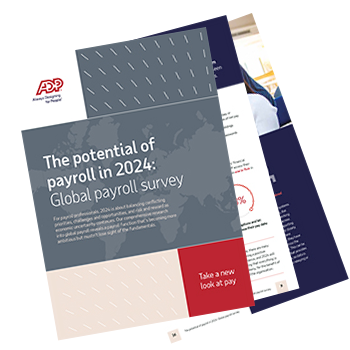The potential of payroll in 2024: A global payroll survey
Every year we speak to senior leaders with payroll responsibilities in multinational companies. We do this to better understand their perception of how their payroll functions are performing across these global organisations.
Our aim is to assess payroll’s performance, resilience and strategic contribution to their businesses worldwide, as well as report on the potential of payroll now and in the future. This year’s report is titled ‘The potential of payroll in 2024: A global payroll survey’. We’ve documented our findings which you can download.
Balancing payroll priorities
The devastating effect of COVID on many businesses was a wake-up call on the need to take a more innovative approach to payroll operations. This means businesses need to make their payroll functions more future-focused and pragmatic, with a focus on better integration across the board.
Our study shows that the following factors are driving payroll transformation initiatives over the next two to three years:
- Cost efficiencies – 33%
- Digitalisation – 33%
- Operational/productivity efficiencies – 30%
- Improved employee experience – 30%
What do organisations want to gain from a payroll transformation?
To deliver payroll efficiently, there need to be fundamental changes to the way payroll functions operate. Changes to processes, tools and skills within the payroll organisation are necessary for an effective transformation.
Our study, ‘The potential of payroll in 2024: A global payroll survey’, which you can download, lists the top priorities for organisations wishing to transform their payroll functions. Some of these are:
- Improved employee experience
- Integration between business systems and payroll
- More reliable technology
- Tighter data security
Key findings: four main themes
Employee experience is top of the agenda – but what about payroll accuracy?
As a business with many employees, ensuring accurate processing of your payroll is essential for employee retention. Maintaining payroll accuracy will ensure your business meets its employee, regulatory, legal and shareholder obligations.
Download our report to read about this in more detail. Here are some of the stats our study uncovered:
- The average payroll accuracy rate is just 78%
- There are clear signs that systems and processes need to be streamlined, connected and digitalised more effectively to reduce the chance of errors.
Balancing a global view with local expertise
In today’s global marketplace, firms need a holistic view of their business while maintaining local insights for a true advantage over the competition. It’s the same with payroll information.
Payroll needs to be localised enough to adhere to specific geographical governance laws and conventions, but also have visibility of payroll information across all countries, which will enable them to inform business strategies.
Our study, ‘The potential of payroll in 2024: a global payroll survey’, downloadable, goes into more detail.
Here are just a few points to consider:
- 31% say they can only access some data across their business, but it’s not standardised
- Many organisations lack the structure and technology for joined-up reporting and analytics
Making the IT case for global payroll
Data security is of the utmost importance when handling payroll data for your organisation. You must be up to date on data protection regulations and have processes in place to mitigate against any data breach.
In our study, minimising IT complexity is a case for change:
- On average, respondents estimate that IT resources are spending 22 hours per week, per country managing data flow between payroll and other business systems
- Many businesses have developed a data security playbook and contingency plans for some countries only (36%), while others (13%) have no contingency plans in place at all
- 99% said data security in their payroll strategy had become important over the last 12 months, and 46% said critically so
From operational to strategic – the modern payroll team
As businesses navigate the choppy waters of a challenging economic landscape, operational efficiency is paramount to an organisation’s success. A combination of the right payroll strategies and payroll talent will help an organisation achieve its business ambitions, as well as help future-proof it against unforeseen challenges.
To find out more about what senior payroll leaders had to say about the modern payroll team, download our study, ‘The potential of payroll in 2024: A global payroll survey’.

In the meantime, below are some of the key takeaways from our study:
- 57% say their payroll service has been affected by a shortage of payroll staff
- 67% of employers are training existing, non-payroll staff to work in payroll
- Payroll leaders are increasing their team’s focus on areas such as data security, data analysis, new emerging technologies, BPI (business process improvement) and strategic planning


